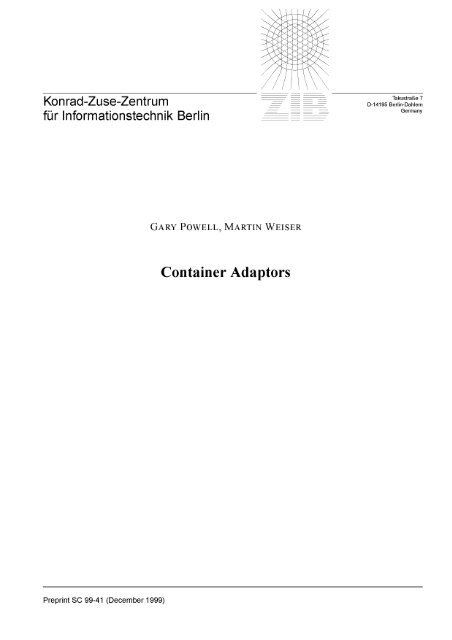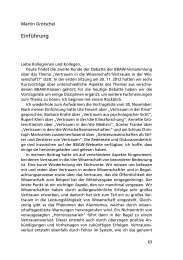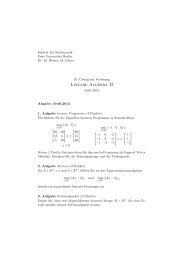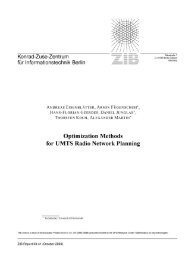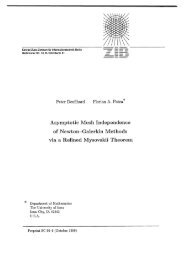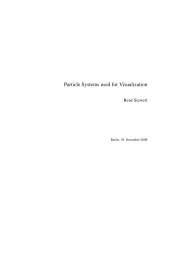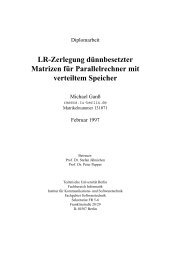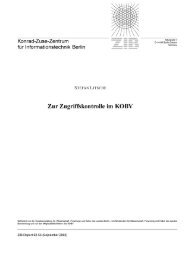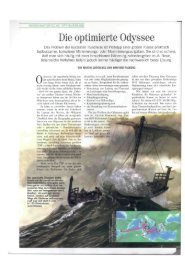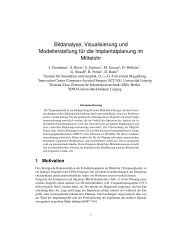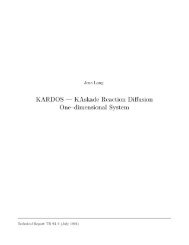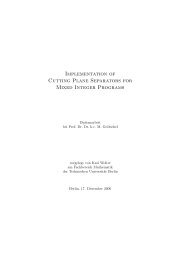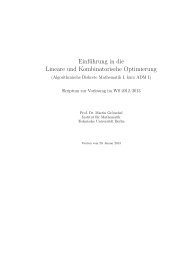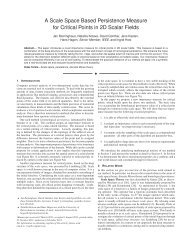Container Adaptors - ZIB
Container Adaptors - ZIB
Container Adaptors - ZIB
Create successful ePaper yourself
Turn your PDF publications into a flip-book with our unique Google optimized e-Paper software.
Konrad-Zuse-Zentrum<br />
fu¨r Informationstechnik Berlin<br />
Takustraße 7<br />
D-14195 Berlin-Dahlem<br />
Germany<br />
GARY POWELL,MARTIN WEISER<br />
<strong>Container</strong> <strong>Adaptors</strong><br />
Preprint SC 99-41 (December 1999)
<strong>Container</strong> <strong>Adaptors</strong><br />
Gary Powell<br />
Sierra On-Line<br />
3380 146th PI SE (J300 Bellevue, WA 98007, USA<br />
e-mail: gary.powell@sierra.com<br />
Martin Weiser<br />
onrad-ZuseZenrum für Informationstechnik<br />
Takusr. 7, 14195 Berlin, Germany.<br />
e-mail: weiser@zib.de<br />
erlin<br />
Absac<br />
The C++ Standard template library has many useful containers for<br />
data. The standard library includes two adpators, queue, and stack. The<br />
authors have extended this model along the lines of relational database<br />
semantics. Sometimes the analogy is striking, and we will point it out<br />
occasionally. An adaptor allows the standard algorithms to be used on<br />
a subset or modification of the data without having to copy the data<br />
elements into a new container. The authors provide many useful adaptors<br />
which can be used together to produce interesting views of data in a<br />
container<br />
CR Classification: D.3.3, E.2<br />
Keywords:<br />
C++, STL, views<br />
Introduction<br />
When manipulating large containers of data, it would be handy to be able to<br />
use the algorithms in the standard template library. By using an adaptor a<br />
container can be made to appear to the algorithm as if it contained only th<br />
elements of interest.<br />
Although all the standard algorithms work on ranges instead of containers<br />
there may be algorithms that rely on beginQ and end(), peraps rbegin() and<br />
rendQ as well as the typedefs for iterators and perhaps something like size() or<br />
swap(). In these cases, smart iterators are not powerful enough. Smart iterators<br />
(see [1]) are adpators of iterators instead of adpators of containers.<br />
Views are a natural way to write smart iterator factories. In fact, most of<br />
e algorithmic intelligence of views is encapsulated in their iterators.<br />
From a more theoretical point of view, the views provide a layer of abstraction<br />
that is compatible with he STL. These container adaptors are thus a
natural way of ending the STL container concpt in te same way as smar<br />
iterators do with the iterator concept.<br />
Views can simplify writing class interfaces. Assume you have a class that<br />
contains nodes, edges, and patches (perhaps a graph package or a finite element<br />
mesh - the latter is something we use views for). If you want to provide some<br />
restricted access to the graph data, how do you do this? You could make the<br />
node, edge, and patch containers public (shock!). Maybe the node container<br />
is a polymorphic container of interior nodes and boundary nodes. Users of<br />
the mesh would then have to deal with a container of pointers. Alternatively<br />
you could provide beginNodes0, endNodesO, beginEdgesO, ..methods.<br />
And don't forget the numNodesO, numEdgesO, .and perhaps the node(),<br />
edge(), ...random access methods Still like it? We didn't. Our solution:<br />
Present apropriately adapted views that reference the internal containers. Writ<br />
ing nodes.begin() or edges.size() is better and easier to remember than<br />
numEdges (or was ist imm_edges? or size_edges? or ...) Views present t<br />
standard interface people are used to wen dealing wit STL containers. 1<br />
Usage Examples<br />
As an example, if we have a container of employees, and we want to find th<br />
oldest one, we can create a functor with a operator () (Employeefe) which re<br />
turns the age of the employee. Then we can create a transformed view of th<br />
container and call max_element and get the employee record which we desire.<br />
// A really minimal Employee Record<br />
struct Employee {<br />
ate dateOfBirth;<br />
eight curreight;<br />
eight curreight;<br />
Salary currSalary;<br />
Name currName;<br />
};<br />
typedef container Employee<strong>Container</strong>Type;<br />
Employee<strong>Container</strong>Type AllEmployees;<br />
Time getAge(Employee const& e) const<br />
{ return today() - e.dateOfBirth; }<br />
typedef transform_view< Employee<strong>Container</strong>Type,<br />
Time (*)(Employee constft) ><br />
ateOfBirthView;<br />
1 Before we go too far, we will be using algorithms from the standard template library<br />
hereafter known as STL. The STL code is in the namespace std, rather than clutter up our<br />
examples with std: :this and std: :that, we have ommitted specifing the namespace. In<br />
actual code you will have to either open the namespace std, or list the algorithms with using<br />
statements, or specify the namespace at the actual call. Also we will be creating classes whose<br />
only method is the operator () (). These classes are known as functors
Search global Employee <strong>Container</strong>.<br />
Employeefe getOldestEmployeeO<br />
ateOfBirthView dobv(AHEmployees, getAge)<br />
ateOfBirthView::iterator OldestAge = max_element(dobv.begin(),<br />
dobv.end() );<br />
Employeefe OldestEmployee = *(OldestAge.get());<br />
return OldestEmployee;<br />
Here we use the type container to represent any STL compliant container<br />
which is not a collection of pairs like map or set. We have also provided a get ()<br />
function in the transform iterator class to return the underlying container itera<br />
tor. You could use a map or set but that would require another transformation<br />
so we'll get to that later.<br />
The DateOfBirthView resembles a projection in relational algebra followed<br />
by a simple transformation, as realized by te SQL statement<br />
ELECT age(ateOfBirth) FROM AllEmployees.<br />
Most of the work done by the view is in the transf orm_view class whic<br />
maintains a reference to the original container, and a functor (which actually<br />
may or may not be a function pointer). The functor is passed to the<br />
transf orm_iterator class and then is applied to the data the iterator points<br />
to whenever operator*() is called. This transformation iterator makes the<br />
data appear as if it were something else. In this case it makes an Employee<br />
reference appear as a Date to the algorithm max_element. We then retrieve an<br />
iterator in the original domain container by calling get().<br />
Now if we only wanted to print a list of employees who were born after a<br />
certain date, we could apply a filtering view to the Employee<strong>Container</strong>. irst<br />
we need to specify te functor to tell us wic employees we want<br />
struct GetOldEmployees {<br />
ate ofInterest;<br />
Get01dEmployee(Date constfe rhs) : ofInterest(rhs)<br />
bool operator()(Employee constfe e) const<br />
{ return e.dateOfBirth < ofInterest; }<br />
};<br />
O<br />
// Create a global ostream operator<br />
OldEmployeeViewType;<br />
// Create the view.<br />
OldEmployeeViewType oev(AllEmployees,
GetOldEmployees(ThirtyearsAgoToday));<br />
// Print the employees who were born before Thirty ears Ago.<br />
// (Our date of interest.)<br />
copy(oev.beginO , oev.endO, ostream_iterator(cout, "\n" ));<br />
The filter_view implements the analogy of te relational algebra select<br />
operation, as realized by the SQL WHERE clause:<br />
ELECT * FROM AllEmployees<br />
WHERE dateOfBirth < ThirtyearsAgoToday<br />
If we wanted to find the maximum salaried employee who is older than thirty<br />
years we can combine the filter view with the transform view to create a view of<br />
just those employees we are interested in and make max_element only see their<br />
salary using the transform function.<br />
// Create a global Salary comparison operator.<br />
bool operator>(alary constfe lhs, alary constfe rhs)<br />
// do some real salary comparison.<br />
return lhs.salary_data > rhs.salary_data;<br />
// Create a function to retrieve the Salary data.<br />
Salaryfe getSalaryO(Employee constfe e) const<br />
{ return e.curralary; }<br />
typedef<br />
transform_view<br />
OldalaryViewType;<br />
DldalaryViewType osvt(oev, getalary );<br />
OldSalaryViewType::iterator iter;<br />
iter = max_element(osvt.begin(), osvt.endO );<br />
*iter = the maximum salary data.<br />
Employeef esiredEmployee = *(*(iter.get() ).get();<br />
Notice how we can build increasingly complex views of our data by layering<br />
these adaptors together 2 . The corresponding SQL statement to the osvt view<br />
would be:<br />
ELECT currSalary FROM AllEmployees<br />
WHERE dateOfBirth < ThirtyearsAgoToday<br />
2 Our views concept is based on the ideas of Jon Seymour [4] from 1996. He constructed a<br />
view that contained a transformation as well as a filter and thus resembled the SQL statement<br />
even closer than our current approach. But since transformation and filtering are useful in<br />
their own right, we decided to decouple these tasks and to create a lean, orthogonal interface<br />
Of course, the functionality offered by both approaches is the same
Now suppose we have sorted our collection of employees by some criteria s<br />
salary. And now we'd like to print out a list of the middle of the collection. W<br />
could make a range_view of this collection.<br />
Employee<strong>Container</strong>Typeiterator start = AllEmployees.begin();<br />
Employee<strong>Container</strong>Typeiterator end = start;<br />
advance(start, AllEmployees.size()/4);<br />
advance(end, AllEmployees.size() * 3/);<br />
typedef<br />
range_view<br />
RangeViewEmployeesType;<br />
RangeViewEmployeesType rve(start, end);<br />
copy(rve.begin(),rve.end(),<br />
ostream_iterator(cout,\n"));<br />
Now you may ask why did we bother creating another container from two<br />
iterators? When we could have just as easily written the for loop with the<br />
original iterators. Good question, in this case no good reason at all. However<br />
if you had written a template which relied on a container having the standard<br />
functions, beginQ, and end() (e.g. most of the views rely on referencing a<br />
container instead of a range) it would not have worked to pass in two iterators<br />
In this way we make the sub range look like the whole container.<br />
If you would like to view this data in reverse order you could apply a<br />
reverse_view. The reverse_view does what you would expect by having<br />
begin () return the rbeginO iterator. Thus unlike the standard algorithm it<br />
requires a bidirectional container. The advantage to using a view is that a copy<br />
of the data is not required.<br />
typedef reverse_view ReverseEmployeeView;<br />
ReverseEmployeeView rrve(rve);<br />
copy(rrve.begin(), rrve.end(),<br />
ostream_iterator(cout,<br />
\n"));<br />
Again we could use the filter view and/or the transform view, to make this<br />
sub range appear as a container of a different type, or set of elements We'll<br />
leave this as an exercise to te reader<br />
Views Survey<br />
In this section we will give a sort survey of most of te views contained in t<br />
library.<br />
First, is map_keys. This view uses te transform select_lst to make a map<br />
appear as a collection of keys We also have coded its counterpart map_values,<br />
where the transform function is select_2nd. These views work on all pair<br />
associative containers. Tis may be more than maps. map_values is useful
when you want to view a map as an unorderd containe, perhaps to apply a<br />
transform or filter to search for a subset of the data. An example would be<br />
a map of football players stored by their NFL ID, to find the rookie running<br />
back of the year, filter for rookies, then transform for yards rushed, then call<br />
max_element on the resulting view.<br />
Secondly, downcast_view. This view calls dynamic_cast on a container<br />
of pointers, it then filters out the elements which return zero from the call to<br />
dynamic_cast, and then converts the pointers to references. With this view<br />
you can take a container of heterogenous objects, all ineriting from some base<br />
class and view them as a collection of derived objects<br />
This sounds way more complicated than it is. We are using two transf<br />
orm_views and one f ilter_view. The first transform does the dynamic_cast,<br />
then we use the f ilter_view to skip the elements that return a zero. Then<br />
we use a transf orm_view to promote the pointers to references. In fact we<br />
realized that for containers of pointers to heterogenious objects promotion of<br />
a pointer to a reference would be useful on its own. We therefore created t<br />
polymorphic_view and used it as part of the the downcast_view.<br />
The friction between generic programming and object oriented program<br />
ming shows up in the problems you have to face when representing polymorphic<br />
collections with STL containers. The only possibility is to use a container of<br />
pointers to the objects. But then it is unsatisfactory to present a pointer to<br />
base class interface wen conceptually we have a container of base class objects<br />
The polymorphic view just puts a dereferencing layer on top of the pointer to<br />
base class interface and presents an interface that matches the concept.<br />
The authors have a number of other useful views which we will discuss in<br />
brief. We have a union_view which concatinates two containers head to tail.<br />
merge_view whic uses a sorting predicate to select the element of two containers<br />
to use next. A set_intersection_view which given two sorted containers<br />
will return the elements whic are in both containers. A set_dif f erence_view<br />
which returns the elements wich are in one set and not te other. A set_symmetrical_dif<br />
f erence_view which returns the elements which are in one or th<br />
other set but not in both. A set_union_view which returns the elements in<br />
two containers less the elements which overlap. A unique_view, which for a<br />
sorted container returns the elements which are not duplicates. We also have<br />
a intersection_view, difference_view and symmetric_difference_view<br />
which do not require the elements to be sorted. These views will use the f ind()<br />
member function of either container if it exists. While this is not efficient if you<br />
had to do it anyway, your alternative is to copy the data into a sorted container,<br />
or do this comparison manually. The view at least provides an efncent<br />
implementation of an inefficent process.<br />
How were we able to make all these views without writing code for the last<br />
few years? We applied the age old technique of divide and conquer. For the<br />
sorted views we created a group of utility views which could be applied in layers<br />
The lowest layer is the equal_range_view applied to each of the two containers.<br />
equal_range_view returns a range_view for each group of elements in<br />
a container marking the beginning and end of runs of equal elements. Nex<br />
we use a pair_merge_view which merges a pair of equal_equal_range iterators,<br />
where each pair element has either a element from the equal_range_view,<br />
or a range_view of end() from each container. Then the pairs are choosen<br />
from te elements wic satisfy a conditional We default to using the stan-
dard functor equal_to. To create the set_*_views we then applied a trans<br />
form to select the elements from the pair we wanted. For instance to make a<br />
set_intersection_view we only return the elements from a pair_merge_view<br />
which have elements in both he pair.first and pair.second. We ten appl<br />
a concatenation_view which returns the elements one by one from the trans<br />
formed view. W have extracted a common base which is reall just a template<br />
of typedefs for the sorted views and then wrote 5 transform functors. Since<br />
each layer could be tested independently it was remarkably easy to do. Ok, it<br />
took us a while to decypher the error messages but once we were done we could<br />
be confident that the oter views would work as well and in fact that was th<br />
case 3<br />
set_intersection_view: 1,3,3 set difference view set union view<br />
concatenation view: 1,3,3<br />
~\ transform view: (1),(),(3,3),() s-<br />
pair_merge_view: ((1,1),(1)),((),(2)),((3,3),(3,3)),((4,4),())<br />
equal_range_view: (1,1),(3,3),(4,4) A: 1,<br />
•<br />
equal_range_view: (1),(2),(3,3)<br />
B: 1,<br />
-~*<br />
V<br />
u<br />
^<br />
^ defines transform<br />
^ references<br />
Hs " inherits<br />
Figure 1: Sorted views composition. Values are eamples for te intion of<br />
containers A and B.<br />
We have also created the f iltered_map_keys, the transf ormedJiltered_<br />
map_keys and their cousins for map_values. These views are templates with the<br />
proper inheritence applied of f ilter_view and transf orm_view to the basic<br />
map_keys, and map_values.<br />
Another interesting view which demonstrates the power of views over copying<br />
the elements is the crossproduct_view. For two random access containers we<br />
apply a operation and return the result for each [i,j] of the containers. The<br />
default operation is a pair of references to the elements, however any functor<br />
which takes two elements is allowed. This allows for delayed evaluation and<br />
sparse storage of a matrix made by (a op b) We did create a proxy template<br />
so that crossproduct_view[i] [j] returns the correct (i op j) result. Thus,<br />
the crossproduct_viewis the analogon of the cross join operation in relational<br />
algebra, as realized by the SQL statement ELECT * FROM Tablel, Table2. In<br />
3 We didn't start out with a layered approach to the sorted container views. We first tried<br />
the "each container does all the work" approach and ended up with a very complex set of<br />
code which was difficult to debug and may still, not have all the bugs removed. We have<br />
abandoned this code. The curious can find it on our web site under the abandoned directory
general this is only interesting in combination with a filter _view eliminating<br />
nonmatching rows, and of course the views performance will not match hat of<br />
sophisticated database engines in this case.<br />
lexible Code<br />
The advanced template mechanisms of C++ like template template parameters<br />
and default template parameters facilitate the construction of highly config<br />
urable yet easy to use code. In this section we will explain some of te aspects<br />
hat make the views code that fleible.<br />
wnership. Views can own the underlying container or merely reference it<br />
We did this by specifing an argument to the view's template. The tag view_ref<br />
references the container, and view_own has ownership properties. Tis allows<br />
you to nest views together. The innermost view can be specified by te user of<br />
he view, the next layers require ownership.<br />
Mutability. Views can be constant or mutable. We provided two tag classes<br />
const_view_tag, and nmtable_view_tag to allow specification. We default to<br />
const_view_tag because in our practice we have found that to be the most<br />
useful. A const_view_tag uses only t const_iterator from he underlying<br />
container<br />
Snsible defults. One of the techniques we use etensively to increase the<br />
flexibility of the code while keeping ease of use and a relatively small code<br />
base are traits classes [2]. Traits are used to add or remove reference/pointer<br />
indirection and const specifiers to or from types, and to select sensible iterator<br />
category defaults for the view's iterators. The latter we will describe in some<br />
detail.<br />
Some views limit their iterator categories. A f ilter_view e.g. is at most<br />
bidirectional. Views combining two containers, e.g. union_view, are limited by<br />
the less powerful of the containers involved. The common denominator in both<br />
cases is the less powerful iterator category. To be easy to use while keeping flex<br />
ibility, the views compute the apropriate iterator category as a default template<br />
parameter at compile time, thus adapting themselves to the given container(s)<br />
In order to identify the maximum iterator category for a view, we imple<br />
mented a very interesting set of trait templates. The algorithm is simple: Map<br />
the two iterator category tags to integers, choose the smaller one and map it<br />
back to the corresponding iterator category tag. Note that this has to be done<br />
at compile time. This kind of technique was invented by Veldhuizen [5].<br />
First we set up a template to give us the minimum value of two integers<br />
Since this is a compile time determination we could not use the standard li<br />
brary min template, instead we use the ?: operator in an enumeration. Nex<br />
we created the combine_traits template that encapsulates the whole algo<br />
rithm. Notice that two of the template arguments to combine_traits are<br />
templates, map mapping categories to integers, and inv it's inverse. Accord<br />
ingly, te map template provides an enum x, and inv provides a type named<br />
type. Ten we created the integer mapping for iterator category tags, specializing<br />
eac type wit a different value in ascending order of their inclusiveness
The random_access_iterator_tag's has the highest value, and input_iterator_tag's,<br />
the lowest reflecting their priority for our purpose. Now when we call<br />
combine_iterator_categories with two iterator category tags, we end up with<br />
e two specializations for those categories, the combine_traits specializes on<br />
the minimum value, and sets the typedef type to the correct type. This is a<br />
very powerful use of the traits technique. It allows us to at compile time select<br />
the correct minimum iterator_trait_tag from the container or view specified.<br />
For example, if a view is at best bidirectional, but the underlying container<br />
is random access, we will set the view's iterator catagory to bidirectional. We<br />
have used this technique to simplify the encoding of the views templates in a<br />
lot of places<br />
//<br />
// Combine traits computing the common denominator of two types.<br />
// This works via a mapping to integers, taking the minimum and<br />
// mapping back to corresponding types.<br />
//<br />
template<br />
struct min_traits { enum { x = a
template struct mapping_iterator_tag<br />
{ typedef std::forward_iterator_tag type; };<br />
template struct mapping_iterator_tag<br />
{ typedef std::bidirectional_iterator_tag type; };<br />
template struct mapping_iterator_tag<br />
{ typedef std::random_access_iterator_tag type; };<br />
template <br />
struct combine_iterator_categories<br />
public combine_traits {};<br />
template<br />
struct combine_iterator_tags<br />
public combine_traits<<br />
stditerator_traitsiterator_category,<br />
stditerator_traits::iterator_category,<br />
std::iterator_tag_mapping,<br />
mapping_iterator_tag> {};<br />
Comparisons. All of the views provide the two basic comparison functions<br />
operator==(), and operator, = which can be expressed by combining th<br />
first two comparisons. We also provided the conversion operators so that assignment<br />
to a const_view from a mutable_view is possible, as is comparison.<br />
The swap specializations were also provided so that swaping of two containers<br />
would be the most efficient. These comparison operators are also provided for<br />
he view iterators.<br />
Views with these interfaces appear to act just like any other STL container<br />
and can be used with STL algorithms. Views are a thin layer on top of their<br />
conatiners therefore te overhead of using them is minimal<br />
A note about the code. We use the ISO C++ template features excessively.<br />
In general this can lead to code bloat since for every set of template parameters<br />
a corresponding variant of the code is instantiated. This can become a major<br />
headache especially for many template paramters. In the views library, this is a<br />
non-issue because it is an extremely thin software layer. Very few methods are<br />
more than six lines long. Thus, nearly all te methods will be inlined by a good<br />
optimizing compiler.<br />
In our implementation we have chosen to use the most advanced template<br />
features of their compiler. This code will not compile on many compilers. Th<br />
reason we did this was simplicity of code and clean design. An early implementation<br />
was requrired to duplicate every view for both const and non const<br />
domain containers. The amount of code was growing out of control. The authors<br />
have this old code, and will be glad to share it but we are not going to<br />
do any more maintaince on it. We anticipate that more compiler vendors will<br />
be able to handle our code soon. The compiler we used was GCC 2.95 hich is<br />
available at the GNU web page for many systems.<br />
he current code base is still in development and available free of carge<br />
10
at [3]. The design architecture appears to have become stable in late '99. New<br />
views seem to occur occasionally as our work projects expand. Contributions<br />
and suggestions for the library are welcome.<br />
Conclusion<br />
The standard template library containers can be easily adapted to act as sub<br />
containers of their data using these adaptors. The adaptors have been used<br />
to help simplify the coding of several projects by the authors and we consider<br />
them very useful tools. With the adaptors provided, programmers can build<br />
interesting views of their own data, and can easily extend and/or combine these<br />
adaptors to view any STL compliant container in other more interesting ways<br />
These views are not meant to replace the standard algorithms which generate<br />
copies of the containers, but rather as an alternative whic may be appropriate<br />
for the problem at hand.<br />
The code is available at t TL omepage<br />
Acknowledgemnts. The authors would like to thank Jon Seymour for pro<br />
viding them wit an initial set of code and the idea of creating views which<br />
would work with te STL containers. And we would also like to thank Jon for<br />
putting us in touch with each other. This is truely an example of the power<br />
of the internet. We would be glad to ear from any users of this code and<br />
suggestions for future improvements<br />
eferences<br />
[1] Tomas Becker. Smart iterators. C/C++ User's Journal, September 1<br />
Nathan Myers. Traits: a new and useful template tecnique. C++ Report<br />
June 195<br />
Gary Powell and Martin Weiser. View Template Library container adaptors<br />
http//www.zib.de/weiser/vtl/, 1<br />
] Jon Seymour. Views a C++ Standard Template Library etension, http<br />
//www.zeta.org.au/~jon/TL/views/doc/views.html,<br />
] Todd Veldhuizen. Techniques for scientific C++. http://extreme.<br />
indiana.edu/~tveldhui/papers/techniques/techniques.ps, 1


